By Leslie King
In the early 1990s I lived on the South side of Chicago. Safety was an issue, so I did what people sometimes do: I went in search of a dog. At the Chicago animal shelter I met Lucky. She was a young Shepherd/Collie mutt. There was something about her…the commanding ears, the dark serious eyes. I thought, “She will keep me safe.” We became regular features at the seminary courtyard that doubled as a dog park several times a day.
When new dogs came to the dog park, Lucky greeted them from head to tail and ran around them as if blessing their presence. She would do a victory lap around the perimeter for each dog who entered. She did this for three years; each and every dog received her shepherding attention. Her shepherding instinct is a beautiful memory for me. She took in whoever arrived. There was some crazy diversity at the dog park. Lucky shepherded the diversity as it arrived.
First Presbyterian Church, like any downtown congregation, has had to have a similar discipline. Diversity has risen up around our congregation over its better than 150 years. Not too many years ago, we had a decision to make in the midst of urban blight and sprawl. The question was, would we continue our ministry in this location or would we find greener pastures?
Even though there were more vacant buildings than occupied, and there was no promise of an uptick in its economy on the horizon, we chose to stick with downtown Waco. First Presbyterian stayed committed to the complex and diverse urban environment.
Years later, things are booming. It’s so very exciting to see the development and expansion. We have stayed mindful of the growing pains as development increases values and taxes. We have held in prayer those who live in poverty, our neighbors at Talitha Koum and Mission Waco, who have settled into an urban core only to experience displacement as it develops. As Waco took off, we knew that sooner or later the issue of how to shepherd in this city would come knocking on our door. And it has…literally…
A real estate developer dropped by the church office one Monday morning asking to speak with me. We were not very far into our conversation when I realized that he was not coming to tell me about changes in the neighborhood. Rather he was coming to invite me/us to help make some changes happen. He looked at me with bright and twinkling eyes and said, “For a mere $200,000, we can simply make Oak Lodge go away!”
Oak Lodge is the Motor Inn across the street from the church. I wouldn’t be surprised to hear some call it a “flophouse.” It is an example of the diversity that has arrived as the city has risen up around us. In our attempts to get to know and understand the people at Oak Lodge, we have appreciated the consultation of Jimmy Dorrell, who has cautioned us as middle class Americans. He has cautioned us about our intent to change people or transform them. He has said to me on more than one occasion, “Don’t try to fix all their problems; there are agencies who are working on that. Just begin learning their names. Look them in the eye and recognize their humanity so that they can recognize yours.” In other words, attend with a shepherding instinct that honors and gathers those who arrive to your shared space. He has been a good guide and friend to us because there are threats to the shepherding instinct.
A first threat has to do with our self-understanding. It is very tempting as church folks to understand that we are the flock to be cared for and guided. And that might be true inside the sanctuary walls, but beyond those walls we need to recognize that our true role is as ambassadors of the Shepherd.
A second threat is in regard to how shepherds work. It’s why Lucky is a helpful image to me of shepherding. You see, I am so often tempted to imagine that a shepherd shops for and selects the sheep. That there are some sheep that are suited to a flock and others that are not. It is humbling to remember that God as Shepherd does not preselect but welcomes and honors all.
So, Oak Lodge becomes a part of who we shepherd, and in so doing we learn from them. We learn about the complex of problems that mire people into difficult, even intractable, situations. Carefully and prayerfully, we take what we know from the challenges at Oak Lodge and we move into places where there is leverage and power for change, for example our partnership with Alta Vista Elementary.
Thanks to what we have learned from our friends at Oak Lodge, we arrive at Alta Vista taking seriously the threat that there are pipelines to prison, and holding onto our belief that the school is situated as a gateway for health, self-esteem, well-being and a promising future. Having learned from the neighbor whom we have sought to shepherd and by whom we have been shepherded, we arrive to Alta Vista with the shepherding instinct intact. We are ready to welcome, guide, instruct, encourage and receive inspiration from the children. We bind up their hope and ours. We bind up their confidence and ours. We bind up their will and ours. At the same time, we loosen the bondage of their fear and ours. We loosen the bonds of uncertainty and despair and in so doing we feel confidence and hope in the smallest achievements.
Around our little lot of land at First Presbyterian Church we have been privileged by neighbors who are postured to teach us if we are willing to learn. If we are willing to say “come to the party and tell us what you know, good bad and ugly,” if we stand alert and ready, then the church continues to be built in the only way it has ever been built, by building up others because we love God and believe in Christ.
 This week’s Act Locally Waco blog post is by Rev. Dr. Leslie Ann King of First Presbyterian Church, Waco. Would you like to write for the blog? If so, please email [email protected]. We would love to hear your thoughts on making Waco a great place to live for every person of every level of income.
This week’s Act Locally Waco blog post is by Rev. Dr. Leslie Ann King of First Presbyterian Church, Waco. Would you like to write for the blog? If so, please email [email protected]. We would love to hear your thoughts on making Waco a great place to live for every person of every level of income.
By Ashley Bean Thornton
(Have you ever been a part of a conversation where you just nodded and pretended you knew what was going on, when really you had no idea what people were talking about? If you do this long enough, you eventually get to the point that it’s embarrassing to ask, and you just make peace with stumbling along in ignorance. I know this from personal experience! For example, even though I think of myself as a fairly well informed citizen of Waco there are still some basic things about how the city works that I only vaguely understand. And – even though it probably only takes 5 minutes to Google it – I just never get around to it.
Assuming that I’m not the only one out there with this particular character flaw, Act Locally Waco is starting a blog series called “Waco 101.” The idea will be to use a blog post every now and then to explain some aspect of how the city works – maybe some term or process you read about in the paper all the time, but don’t really understand. It’s for those of us who want to be informed citizens, but are just too dang busy (or lazy!) to look stuff up. Do you have ideas for topics for this series? If so, send me an email at [email protected] and we’ll try to find someone to write about it. No one needs to know it was you who asked! Thanks! — ABT)
If you have ever read an article in the Trib about downtown Waco, you have probably come across the acronym “TIF,” as in…
- “$35 million TIF Grant to Baylor Stadium Project is right for downtown development”
- “Waco’s TIF Fund grows, building hope downtown,”
Or, most recently…
…but, what the heck is “TIF?”
The acronym “TIF” stands for “Tax Increment Financing.”
Tax Increment Financing (TIF) is a way for the city to encourage development in an economically distressed area by investing tax revenues. The basic idea is that there are certain areas in the city that would be beneficial to develop, but, to be frank, they are in such bad shape that it is difficult to entice investors to take the plunge. To help with this dilemma, the City of Waco can encourage investment by agreeing to pay some of the cost of the development. But, where would the money come from to do that you ask? Enter TIF!
The basic concept of TIF is that a distressed property has a certain original value that generates some amount of tax dollars. After it is renovated, it will have a new, higher value that will generate more tax dollars. This difference in the amount of taxes paid is the “increment” in Tax Increment Financing. The Tax Increment Financing model uses this projected increment to finance improvement projects.
Here’s how it works:
The city identifies a particular area that is economically distressed, but has potential for profitable development. This area is designated as a “TIF zone” for up to forty years. For example, in 1982 the City of Waco established “Reinvestment Zone #1,” which includes part of downtown and a large part of the river front (map). That area is designated a TIF zone until 2022.
Taxes collected the year the TIF zone was established are considered the “baseline” taxes for the zone. The Taxing entities (in our case, the City, McLennan County, McLennan Community College and WISD) agree that, for the length of the TIF agreement, they will take only that baseline amount each year. Any taxes collected above that baseline will be put into a fund to be reinvested in the TIF zone. This difference between the baseline taxes and the actual taxes collected is the “increment.”
TIF funds can be used for variety improvements: affordable housing, transit facilities, demolishing a building, or preserving the façade of a building, among others. (Here’s the link to the city’s TIF Guidelines.)
Developers who are interested in investing in the TIF zone can ask for TIF funding to help with eligible parts of their projects. This reduces the developer’s expenses and helps encourage renovation in the zone. When the renovation is complete, the property is more valuable, which results in higher property taxes, which replenishes the TIF fund.
Developers who are interested in receiving this kind of funding start the process by checking with the City Manager’s office to see what parts, if any, of their projects are eligible for TIF funding. If some parts are eligible, the developer may submit an application for formal consideration of funding.
Eligible funding requests are presented to the Board of Directors for the TIF zone. The Board of Directors is appointed by the taxing entities. There are eight members on each TIF board in Waco: one each appointed by Waco ISD, McLennan County, and McLennan Community College and five appointed by the Waco City Council. This board reviews the proposal and makes a recommendation to the City Council as to whether or not to accept the proposal.
If the City Council does accept the proposal, the city enters into a contract with the developer to reimburse the agreed upon TIF-eligible work.
This reimbursement might happen in any one of several ways, for example:
- The developer might pay the cost of the approved improvement, and then be reimbursed over time from the increased tax revenues, or…
- The city might pay for the improvement directly out of the existing TIF funds, or…
- the improvement might be paid for by the sale of a bond, that would then be repaid over time out of the tax increments.
This model of funding has been used to help incentivize all kinds of downtown Waco development projects from the MLK Pedestrian/Bike Trail, to the American Football Coaches Association parking lot to – more famously – parts of the McLane Stadium project and The Magnolia Silos project. The most recent big TIF commitment is for the “Brazos Promenade” riverfront development scheduled to break ground in 2017.
Clearly this model of funding has had a huge impact on Waco especially in downtown. It will be interesting to see what the future holds between now and 2022 when TIF zone #1 reverts back to the regular tax rolls!
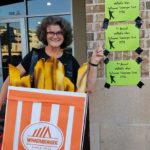 This Act Locally Waco blog post is by Ashley Bean Thornton, she works at Baylor, helps out with Act locally Waco, and facilitates the Waco Foundational Employment Network which is a part of Prosper Waco. She likes to walk and doesn’t mind at all if you honk and wave when you see her.
This Act Locally Waco blog post is by Ashley Bean Thornton, she works at Baylor, helps out with Act locally Waco, and facilitates the Waco Foundational Employment Network which is a part of Prosper Waco. She likes to walk and doesn’t mind at all if you honk and wave when you see her.
The Act Locally Waco blog publishes posts with a connection to these aspirations for Waco. If you are interested in writing for the Act Locally Waco Blog, please email [email protected] for more information.
By Emily Clark
 The Mayborn Museum has just opened Design Den, a new permanent exhibit space that focuses on making and tinkering with real tools, real technology, and real materials. As Design Den Coordinator, I get to spend my days testing fun new projects, like designing paper masks with LED circuits and building marble roller coasters out of toilet paper rolls! It’s seriously a dream job, but it can be hard to explain to people what it means to make and tinker.
The Mayborn Museum has just opened Design Den, a new permanent exhibit space that focuses on making and tinkering with real tools, real technology, and real materials. As Design Den Coordinator, I get to spend my days testing fun new projects, like designing paper masks with LED circuits and building marble roller coasters out of toilet paper rolls! It’s seriously a dream job, but it can be hard to explain to people what it means to make and tinker.
 The “Maker Movement” has been gaining in popularity across the nation and around the world, but it’s really nothing new. As humans, we have always been makers. That’s how we have come to live in such a technologically rich world! The only downside? Technology has really spoiled us. Why would I make my own when I can just buy it at the store? The Maker Movement and Do-It-Yourself culture have recently gained traction as a way to reclaim our inventive nature. Make your own soap! Make your own furniture! Make your own robot! (Or at least put the tutorials on your Pinterest board and totally make them later.) There’s a pride and sense of accomplishment in creating something all on your own. Not to mention, it is fun!
The “Maker Movement” has been gaining in popularity across the nation and around the world, but it’s really nothing new. As humans, we have always been makers. That’s how we have come to live in such a technologically rich world! The only downside? Technology has really spoiled us. Why would I make my own when I can just buy it at the store? The Maker Movement and Do-It-Yourself culture have recently gained traction as a way to reclaim our inventive nature. Make your own soap! Make your own furniture! Make your own robot! (Or at least put the tutorials on your Pinterest board and totally make them later.) There’s a pride and sense of accomplishment in creating something all on your own. Not to mention, it is fun!
Museums have picked up on this trend of making and tinkering. Places like the New York Hall of Science’s Makerspace and the Exploratorium’s Tinkering Studio have lead the charge, and they have noticed something that is pretty cool: we learn best by doing! Making and tinkering are especially effective ways to learn because we become invested in our projects. I may use math to measure the perfect piece of cardboard. I apply physics when I realize that my marble roller coaster needs a steeper incline. I hone my communication skills when someone asks about my project and I have to explain my own thought process. Perhaps most obviously, I learn to problem solve. If my LED mask isn’t lighting up, there may be something wrong with my copper tape circuit. I move a few pieces of tape and adjust the battery and…. Voila! It works!
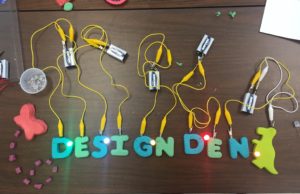 Here at the Mayborn Museum, we have been busy making and tinkering in Design Den since we announced the new space in May. We began this summer by prototyping different activities with the help of our teen volunteers. After observing visitors and listening to their comments, we found that making and tinkering activities were very popular. Some of our favorite activities were Inflatables, Squishy Circuits, and Paper Animatronics.
Here at the Mayborn Museum, we have been busy making and tinkering in Design Den since we announced the new space in May. We began this summer by prototyping different activities with the help of our teen volunteers. After observing visitors and listening to their comments, we found that making and tinkering activities were very popular. Some of our favorite activities were Inflatables, Squishy Circuits, and Paper Animatronics.
This fall, Design Den has opened in its permanent exhibit space. We have a front area of Design Den where guests can drop in anytime to build their own creations using different types of blocks. The back area of Design Den is a new workshop space where we invite guests to make and tinker for special events and programs. At our Halloween event, guests made their own LED paper masks in the workshop.
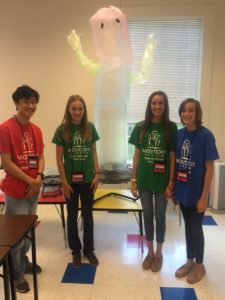 Design Den has also been busy this fall connecting with the Waco community. In October, we made LED Wearable Pins with festival goers at Science Fest. Later that month, we talked with high school students about careers in museums and invited them to tinker with Squishy Circuits at City of Waco STEAM Day. We even made stop motion videos at the Farmer’s Market in a partnership with the Museum Association of Waco’s Traveling Museum, a project coordinated by Matt Doyen, Baylor Museum Studies graduate student and Graduate Assistant for Design Den.
Design Den has also been busy this fall connecting with the Waco community. In October, we made LED Wearable Pins with festival goers at Science Fest. Later that month, we talked with high school students about careers in museums and invited them to tinker with Squishy Circuits at City of Waco STEAM Day. We even made stop motion videos at the Farmer’s Market in a partnership with the Museum Association of Waco’s Traveling Museum, a project coordinated by Matt Doyen, Baylor Museum Studies graduate student and Graduate Assistant for Design Den.
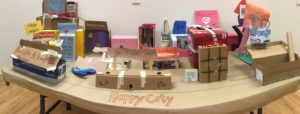 In late October, Design Den joined the rest of the museum in welcoming families from Brook Avenue Elementary and West Avenue Elementary at our first Family Science Night, planned in conjunction with Prosper Waco. At Family Science Night, one of our activities had participants use recycled materials to make something to add to our Happy City. We asked, “What do you think a city needs to be happy?” You can see in the photo below that we had an airport, an art gallery, coffee shops, a hospital, and even a science museum!
In late October, Design Den joined the rest of the museum in welcoming families from Brook Avenue Elementary and West Avenue Elementary at our first Family Science Night, planned in conjunction with Prosper Waco. At Family Science Night, one of our activities had participants use recycled materials to make something to add to our Happy City. We asked, “What do you think a city needs to be happy?” You can see in the photo below that we had an airport, an art gallery, coffee shops, a hospital, and even a science museum!
Our last event for 2016 will be our Christmas at the Mayborn event on December 1. In Design Den, we will be making pop-up holiday cards and ornaments. We have a special activity, making stockings decorated with sewing circuits and LEDs, reserved for guests ages 8 and up.
 The coolest thing of all is that making is happening all over Waco. Places like Maker’s Edge on Austin Avenue, Waco ISD’s Greater Waco Advanced Manufacturing Academy (GWAMA), and even Midway Middle School’s new makerspace have begun to engage the community in making and tinkering. At Design Den, we love the idea of introducing our guests to a making and tinkering mindset that leads to bigger and better and even more awesome making, whether that’s at the Mayborn or somewhere else in Waco. Happy making!
The coolest thing of all is that making is happening all over Waco. Places like Maker’s Edge on Austin Avenue, Waco ISD’s Greater Waco Advanced Manufacturing Academy (GWAMA), and even Midway Middle School’s new makerspace have begun to engage the community in making and tinkering. At Design Den, we love the idea of introducing our guests to a making and tinkering mindset that leads to bigger and better and even more awesome making, whether that’s at the Mayborn or somewhere else in Waco. Happy making!
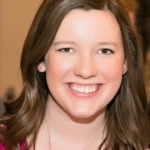 Emily Clark is originally from Joshua, TX, but moved to Waco in 2009 to go to Baylor. She has two degrees from Baylor, her B.S. in Biology and her M.A. in Museum Studies. She was hired on at the Mayborn Museum in May after working there for two years as a graduate assistant. Her husband, Andy, is in his last year at Truett Seminary. They live near campus with their silly pup, Pepper, adopted from the Humane Society of Central Texas. Emily loves to binge watch TV shows, eat queso, and listen to the Eagles.
Emily Clark is originally from Joshua, TX, but moved to Waco in 2009 to go to Baylor. She has two degrees from Baylor, her B.S. in Biology and her M.A. in Museum Studies. She was hired on at the Mayborn Museum in May after working there for two years as a graduate assistant. Her husband, Andy, is in his last year at Truett Seminary. They live near campus with their silly pup, Pepper, adopted from the Humane Society of Central Texas. Emily loves to binge watch TV shows, eat queso, and listen to the Eagles.
The Act Locally Waco blog publishes posts with a connection to these aspirations for Waco. If you are interested in writing for the Act Locally Waco Blog, please email [email protected] for more information.
by Emily Mills
Women in poverty are still the most at risk for being exploited through the commercial sex industry. 89% of women in the commercial sex industry say they want out but have no other means of survival. The business of commercial sex is like any other business, the supply is based on demand. For over a decade Jesus Said Love has been reaching people within the industry, empowering and loving those we serve. And while no two individuals are alike, there are overarching commonalities that we have seen ringing true. Our friends in the industry would not be working if there wasn’t a demand. If there was another viable source of income, most of them would take it. But the demand is high, even in Waco. Most of the industry has moved online. The average age of entry into this industry for a female is 12 years old, around 9 years for a male. This sounds shocking, but it is reality. The demand for commercial sex is a 3.2 billion dollar industry. So at some point, JSL had to ask the question, “What are we doing to affect the demand?”
As part of The Heart of Texas Human Trafficking Coalition, Jesus Said Love is proud to announce “Stop Demand School” (formerly known as “Waco John School”). The first course was offered in McLennan County on October 18, 2016. SDS is a sex buyers intervention program that will work alongside the local justice system with a mission to stop the demand for commercial sex with the vision of restoring lives. Intervention programs for sex buyers are nationally recognized for reducing recidivism. Stop Demand School aims to be another tool for judges and probation officers when sentencing those charged with misdemeanor crimes related to the solicitation of sex. The Heart of Texas Human Trafficking Coalition extends this program to all counties in Central Texas in order to stop the demand of commercial sex exploitation in our communities. Stop Demand School will be housed under the non-profit Jesus Said Love and will run as an educational program of the organization.
Mission Statement:
Stop Demand School is a sex buyers intervention program that aims to end the demand for commercial sex exploitation by educating those charged with solicitation of sex through an eight-hour intervention course.
Offenders pay course fees to Jesus Said Love, an organization that reaches women in the commercial sex industry and provides empowerment programs directly to women. Funds raised will support these programs as well as other agencies serving commercial sex exploits. Using restorative justice principles, the curriculum educates offenders on STDs, addiction, pornography, and the issue of human trafficking as linked to the commercial sex industry. Participants will also hear from a survivor of the commercial sex industry. Stop Demand School also offers free STD and HIV testing through the Department of Public Health as well as resources for recovery. Instructors from DePaul, Baylor University, Public Health Department, UnBound, and Waco PD will be among the facilitators.
Goals:
- To see recidivism drop and the demand for sex in our county measurably decrease.
- To increase stricter punishment for those buying sex.
- To restore offenders to society and provide resources for their individual growth.
Who can come?
Any person in McClennan County arrested for solicitation of a sex crime. Offenders who show up visibly drunk or high will not be permitted to stay and will be escorted off the premise by a police officer.
How it works:
As a community education program, Stop Demand School will gain referrals through the justice system. Judges and probation officers alike can mandate this course as part of the offender’s sentencing. Notification for the course and enforcement comes from probation officers.
Stop Demand School will offer a certificate of completion for offenders after accounting for full attendance.
Stop Demand School will maintain secure and private records of attendance and will notify probation officers of progress and/or no-shows.
The Financials:
Payment of Stop Demand School, an education program of Jesus Said Love, will be paid to Stop Demand School via the website. The course fee is $400. Half of the payment will be due prior to class at the time of registration.
For more information:
Visit the website: www.stopdemandschool.com or call 254-300-7658
 Emily Mills received her B. A. in Communications from Baylor University. While at Baylor, Emily participated in various opportunities to serve the marginalized and lead worship. This began her passionate pursuit to “put feet” on the songs she was singing. In 2003, while leading worship at a conference for women exiting the sex industry, these two worlds collided and Jesus Said Love was born. Emily continues to lead worship around the country with her husband, Brett. They have three children: Hattie, Lucy and Gus. To learn more about JSL, please visit our website JesusSaidLove.com. Contact us at [email protected].
Emily Mills received her B. A. in Communications from Baylor University. While at Baylor, Emily participated in various opportunities to serve the marginalized and lead worship. This began her passionate pursuit to “put feet” on the songs she was singing. In 2003, while leading worship at a conference for women exiting the sex industry, these two worlds collided and Jesus Said Love was born. Emily continues to lead worship around the country with her husband, Brett. They have three children: Hattie, Lucy and Gus. To learn more about JSL, please visit our website JesusSaidLove.com. Contact us at [email protected].
The Act Locally Waco blog publishes posts with a connection to these aspirations for Waco. If you are interested in writing for the Act Locally Waco Blog, please email [email protected] for more information.
By Trey Crumpton
What journey have you taken? What journey will you take? Do you have a friend or relative who has taken a journey according to his/her faith? Might you have occasion to cross paths with someone whose faith tradition is different from yours? These are all questions which we explore in our fall exhibit at the Mayborn Museum at Baylor University. Produced by The Children’s Museum of Indianapolis and the National Geographic Society, Sacred Journeys focuses on important pilgrimages of five major world religions: Christianity, Islam, Judaism, Hinduism, and Buddhism.
It has been a privilege to listen and speak with people from our community who may think and believe differently, engaging in dialogue about our shared spirit and humanity. People journey to add experience and context to their soul, and in some cases, to fulfill tenets within their given faith. We learn together about each person’s tradition, and one might say that this “learning journey” is a sacred one—binding together those who might otherwise remain separate.
 Over the past few weeks, we have participated in several events which highlight our shared emphasis on stories. The Mayborn hosted an interfaith prayer breakfast for the opening of the exhibit, and museum staff were invited to share personal faith journeys at a Cross Cultural Dinner hosted by Baylor Spiritual Life. The panel discussion, Holy Journeys, Holy Destinations included four Baylor professors (Candi Cann, Robert Creech, Elise Edwards, and Matthew Whelan) who discussed what happens when we travel to holy places, how holy places can travel with us.
Over the past few weeks, we have participated in several events which highlight our shared emphasis on stories. The Mayborn hosted an interfaith prayer breakfast for the opening of the exhibit, and museum staff were invited to share personal faith journeys at a Cross Cultural Dinner hosted by Baylor Spiritual Life. The panel discussion, Holy Journeys, Holy Destinations included four Baylor professors (Candi Cann, Robert Creech, Elise Edwards, and Matthew Whelan) who discussed what happens when we travel to holy places, how holy places can travel with us.
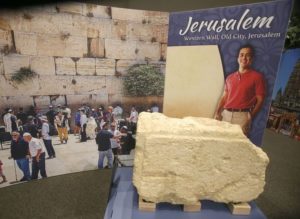 Throughout the fall, the museum will continue to host events which promote dialogue, including an Interfaith Student Panel Discussion on November 10, hosted by Baylor’s interfaith group, Better Together BU. Along with the Greater Waco Interfaith Conference, the museum will host a Festival of Faiths on October 30. The National Geographic film, Jerusalem, will play during select showings on the weekends, through the duration of the exhibit, which runs through December 31.
Throughout the fall, the museum will continue to host events which promote dialogue, including an Interfaith Student Panel Discussion on November 10, hosted by Baylor’s interfaith group, Better Together BU. Along with the Greater Waco Interfaith Conference, the museum will host a Festival of Faiths on October 30. The National Geographic film, Jerusalem, will play during select showings on the weekends, through the duration of the exhibit, which runs through December 31.
A little more about National Geographic Sacred Journeys:
Each year more than 330 million people around the world journey to sacred places as part of their religious commitments. Some seek enlightenment or healing. Others perform acts of devotion that are expressions of deep faith. The new exhibit reflects this diversity of religious and spiritual pilgrimage through immersive environments created with photography from National Geographic. Families will be able to observe, discuss, and begin to understand some of the beliefs and sacred journeys made by people around the world.
Recreated places, spaces, and events invite visitors to learn more about the history and beliefs that support spiritual practices that take place at home and within our congregations. Featured sites include:
- The Western Wall of the Second Jewish Temple in Jerusalem, Israel
- Dome of the Rock, site of Muhammad’s ascent to heaven in Jerusalem, Israel
- The Church of the Holy Sepulchre, site of Jesus’ crucifixion in Jerusalem, Israel
- The Grand Mosque in Mecca, Saudi Arabia, to which all Muslims are expected to make a pilgrimage or Hajj once in their lifetimes
- Tepeyac Hill and the Roman Catholic Basilica of Our Lady of Guadalupe in Mexico City, Mexico
- Allahabad and Sangam at the confluence of three rivers sacred to Hindus at the Ganges River in India, site of some of the largest gatherings of humans on earth
- Bodh Gaya, birthplace of Buddhism, and the Bodhi Tree where Gautama Buddha achieved enlightenment in Bihar, India
- Caves in the bluffs along the Dead Sea in Qumran, Israel where the Dead Sea Scrolls were discovered
 The exhibit will come to life through the personal stories of children and families who participate in sacred journeys or practices. Connecting with these experiences will allow visitors to learn how pilgrimage and revered artifacts reflect religious traditions and the cultures associated with those religions.
The exhibit will come to life through the personal stories of children and families who participate in sacred journeys or practices. Connecting with these experiences will allow visitors to learn how pilgrimage and revered artifacts reflect religious traditions and the cultures associated with those religions.
“The Sacred Journeys exhibit promises to be a very rewarding project. Many Americans associate the idea of pilgrimage with the Middle Ages, but in fact it is a huge reality in the present world, something that affects literally billions of people. Pilgrimage also provides a wonderful way of understanding religious impulses as they are expressed in different world faiths. So we are dealing with something richly educational, something that provides a unique way of understanding different religious traditions, but it’s also breathtaking in terms of the beautiful places and buildings that will be explored.,” says Professor Philip Jenkins, Distinguished Professor of History in the Institute for Studies of Religion at Baylor University as well as the Mayborn Museum’s spokesperson for Sacred Journeys.
 Trey Crumpton is Exhibits Manager for the Mayborn Museum Complex at Baylor University, where he has been on staff for 10 years. He has lived in Waco since 2001, and has two energetic preschoolers who love to discover. His beautiful wife Ashley is an early childhood educator, and together they are proponents of all things educational, enriching and fun. Trey loves family, friends, the outdoors, dark chocolate, good books, pizza, and good film.
Trey Crumpton is Exhibits Manager for the Mayborn Museum Complex at Baylor University, where he has been on staff for 10 years. He has lived in Waco since 2001, and has two energetic preschoolers who love to discover. His beautiful wife Ashley is an early childhood educator, and together they are proponents of all things educational, enriching and fun. Trey loves family, friends, the outdoors, dark chocolate, good books, pizza, and good film.
The Act Locally Waco blog publishes posts with a connection to these aspirations for Waco. If you are interested in writing for the Act Locally Waco Blog, please email [email protected] for more information.
by Dena Quigley
October 15th is National Pregnancy and Infant Loss Remembrance Day. Did you know? Five years ago, I was completely and blissfully ignorant. But since then I’ve learned that one in four women will have a pregnancy that ends in either a stillbirth or a miscarriage… one in four! That means when I go to dinner with three friends, one of us should expect such a loss. Multiply that by several tables of women and this number quickly increases. It’s an unpopular conversation starter for sure, but occasionally we need to be made uncomfortable so that we can be made aware.
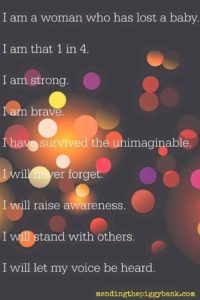 Jay Neugeboren writes, “A wife who loses a husband is called a widow. A husband who loses a wife is called a widower. A child who loses his parents is called an orphan. There is no word for a parent who loses a child. That’s how awful the loss is.” As a mother who has lost her daughter, I can relate to his words and I can attest to the loneliness that comes with such a loss. At Cradled, we often refer to the loss of a pregnancy as a “silent sorrow.” Not everyone can or is willing to relate to such a loss. I’ve had friends literally and figuratively turn their backs on my grief, leaving my husband and I to not only pick up the pieces of our tattered hearts, but to seek out and find new community. I am fortunate that I found Cradled by Love, Hope and Healing, a local group that provides support and resources for women and families experiencing the loss of a baby through miscarriage, stillbirth, early infant loss, and infertility. They gave me shelter to express my fears and sadness, and the support and love I needed to move forward.
Jay Neugeboren writes, “A wife who loses a husband is called a widow. A husband who loses a wife is called a widower. A child who loses his parents is called an orphan. There is no word for a parent who loses a child. That’s how awful the loss is.” As a mother who has lost her daughter, I can relate to his words and I can attest to the loneliness that comes with such a loss. At Cradled, we often refer to the loss of a pregnancy as a “silent sorrow.” Not everyone can or is willing to relate to such a loss. I’ve had friends literally and figuratively turn their backs on my grief, leaving my husband and I to not only pick up the pieces of our tattered hearts, but to seek out and find new community. I am fortunate that I found Cradled by Love, Hope and Healing, a local group that provides support and resources for women and families experiencing the loss of a baby through miscarriage, stillbirth, early infant loss, and infertility. They gave me shelter to express my fears and sadness, and the support and love I needed to move forward.
At Cradled, we are not happy to meet you or have you attend a support group, because that means you have suffered as no parent should suffer. But we will meet you in your grief and loss and walk with you through your journey. We offer empathy, and are willing to climb down into the hole with you, partake in your silent sorrow, and share our experiences along with other practical techniques to help ensure that you won’t be in the hole always. For some families this journey is relatively short, and for others who come to Cradled, we walk a mile, and then a mile more, and another if needed. It is an honor to be with them.
To the other three women who never experience a loss, we, the one in four, celebrate your successful pregnancies with you. You deserve happiness and joy through the life of your baby. All we ask is that you do not forget our babies. Our babies meant just as much to us as yours do to you. We understand that it is difficult to know what to say, but sometimes “I’m sorry, I will always remember” is just enough.

If you, or someone you know, is one in four, please know that Cradled is here for you. If your loss was yesterday, last year or last decade, we are ready to listen to your story. Please visit our website at Cradled.org for more information about upcoming events and support groups.
 Dena Quigley is a recent graduate of Baylor University having earned her PhD in Education. She is a wife and a mother of two beautiful boys on earth and a daughter in heaven. She has been a volunteer with Cradled by Love, Hope and Healing since 2013, and regularly co-leads support groups and is currently help to develop new curriculum.
Dena Quigley is a recent graduate of Baylor University having earned her PhD in Education. She is a wife and a mother of two beautiful boys on earth and a daughter in heaven. She has been a volunteer with Cradled by Love, Hope and Healing since 2013, and regularly co-leads support groups and is currently help to develop new curriculum.
The Act Locally Waco blog publishes posts with a connection to these aspirations for Waco. If you are interested in writing for the Act Locally Waco Blog, please email [email protected] for more information.
By Rolando Rodriguez Soto
Every college student knows about the dreaded Free Application for Federal Student Aid (FAFSA) they have to apply for each year. This year, big changes to the FAFSA will make it easier for students moving forward.
On Sept. 14, 2015, President Obama announced starting with the 2017-2018 FAFSA, students will be able to file as early as October 1 rather than beginning on January 1. This means the FAFSA for next school year starting in fall 2017 is now open.
Don’t panic! I understand you submitted your previous FAFSA just a few months ago! You are probably thinking, “But I don’t know my 2016 tax information yet!” That’s OK. For this next FAFSA you will be using your 2015 tax information–the same tax information you used on your 2016-2017 FAFSA earlier this year.
Beginning with the 2017-2018 FAFSA, students will be using their parents’ income tax information (as well as the students’ if appropriate) from the previous year, which for this upcoming FAFSA will be the 2015 tax return rather than their 2016 tax return. This means during this transitional year, students will be using the same tax information they used on their 2016-2017 FAFSA earlier this year.
“Previously the FAFSA would open in January, and you would have to use the tax return from the year that just ended, but in January, parents don’t have their W2s yet,” said Jessica McAdoo, MAC & Scholarship Coordinator for the MAC College Money Program. “So a lot of students and parents would have to put an income estimate and go back and update it before the March deadline.”
The new FAFSA availability date will make the financial aid process smoother for students. Since parents and students have already completed their 2015 tax return, it should have been already processed through the Internal Revenue Service (IRS), and they will no longer need to use estimates from the prior year.

With the new process, students will be able to use the Data Retrieval Tool to upload their tax information directly onto the FAFSA from the IRS. For most students this means they will no longer need to go back and update their estimated figures on their FAFSA. Since FAFSA will be sending schools tax information directly from the IRS, fewer students will need to complete the verification process.
If you are a high school senior, you may still be sending out admission applications, taking tours of campuses or making the decision of where you want to spend the next years of your education. There is no rush. Students do not need to apply for admission to a school before they list it on their FAFSA.
The priority deadline for state aid is still March 15, so be sure to complete the FAFSA process before that date. Some schools may have changed their priority deadline for FAFSA, so check with your prospective or current schools to verify their deadlines.
The Texas Application for State Financial Aid (TASFA) for non-citizens classified as Texas residents has recently announced their application is also now available to students. Similar to the FAFSA, students will also use their 2015 tax return to complete the form for fall 2017.
Your family’s financial situation may have changed since your parents submitted their 2015 tax return and you filed your previous FAFSA (if you are a returning student). You must still report the same tax information from 2015 on your FAFSA.
“If your financial information has changed you may have to file special circumstance or loss of income paperwork with your financial aid office at your school,” McAdoo said.
Federal Student Aid ID
Before students can begin the financial aid process, they will need to create a federal student aid ID (FSA ID). This form of identification replaced the PIN in spring 2015. Rather than using a four-digit number, students and parents will now create their own username and password. If you haven’t logged in to your FAFSA since May 10, 2015, you will need to create an FSA ID before you can access a federal student aid website.
FAFSA made the change to the FSA ID to increase security. The username and password is more secure than a four-digit number. The new FSA ID will also allow parents and students to retrieve forgotten passwords and log in using an email address.
Both the student and one of his or her parent will need to create an FSA ID. The student ID will be used to log in and sign the FAFSA whereas the parent ID will be only be used to sign the FAFSA.
Students and parents can create their FSA ID at fsaid.ed.gov.
MAC College Money Program
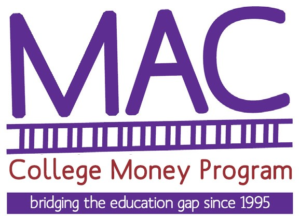 All of this new information on the FAFSA may sound daunting. The MAC College Money Program, a program of Waco Foundation, is available to all students needing assistance with FAFSA, TASFA and financial aid.
All of this new information on the FAFSA may sound daunting. The MAC College Money Program, a program of Waco Foundation, is available to all students needing assistance with FAFSA, TASFA and financial aid.
“The MAC Program helps any student whether you are going to college for the first time or you are returning to college,” McAdoo said. “We fill out the FAFSA at no cost, answer questions about the whole financial aid process, and we are a resource for all students and parents.”
MAC helps 1,500 McLennan County high school graduates annual with the financial aid process. Robbie Stabeno, Director of Scholarships & the MAC Program, and Jessica McAdoo, MAC & Scholarship Coordinator, are available to assist anyone in the county who needs help completing the FAFSA.
If you need assistance, contact the office at (254) 752-9457 to make an appointment.
 Rolando Rodriguez Soto was raised in Waco, TX, and he is currently attending Baylor University with plans to graduate in December 2016 with a Bachelor of Arts in Professional Writing & Rhetoric. After graduation, he hopes to work in Waco in the nonprofit sector to help realize the full potential of Waco. His long term goals include hopefully creating and publishing creative work whether that is a novel, short story or even a television show.
Rolando Rodriguez Soto was raised in Waco, TX, and he is currently attending Baylor University with plans to graduate in December 2016 with a Bachelor of Arts in Professional Writing & Rhetoric. After graduation, he hopes to work in Waco in the nonprofit sector to help realize the full potential of Waco. His long term goals include hopefully creating and publishing creative work whether that is a novel, short story or even a television show.
The Act Locally Waco blog publishes posts with a connection to these Aspirations for Waco. If you are interested in writing for the Act Locally Waco Blog, please email [email protected] for more information.
By Terry Roller
Waco recently received a Cultural Arts District designation from the State of Texas. To many, it is a great thing. To others it is too esoteric, elitist, and a waste of “their” money.
Let me share a brief story as to why I think it IS a big deal and is deserving of support and nurture, why it brings value to all citizens. My wife is originally from Springfield, Illinois. Her family is still there. I will have to say that over much of the thirty-six years she and I have been married, Springfield, especially being the capital of a state as significant as Illinois, wasn’t much of a place to visit multiple times. There didn’t seem to be much to do once one had done all the obvious Lincoln sites. But for a number of the nearly thirty-four years I have lived in Waco, Springfield had one thing that Waco did not have: a certain department store that shall remain nameless. I really liked the merchandise selection, and the prices, especially sale prices. That gave me something to look forward to when we visited.
Well, in the intervening years, the same department store came to Waco—so much for an incentive to visit Springfield other than visiting in-laws of course. Now, having the same store close to home takes some of the shine off the experience of shopping there. Convenience breeds complacency. This is something I have heard referred to as the “Six Flags effect” which says that if one lives very near Six Flags, it really isn’t a big deal. Even the Bible gives an example in the story of the prophet in his own hometown.
So what does this have to do with the Waco Cultural Arts designation? Large corporations have edged out the mom and pop shops and other small businesses in cities and small towns throughout the country, including Waco. Cities and towns have come to look more and more alike, with the same retailers and restaurants, with the same logo-branded clothing, with the same architecture-as-logo buildings, the same non-descript metal buildings built for economy over aesthetics or style. One remaining unique characteristic that can and does make one community different from others is its local arts scene including, visual and performing arts, music, regional architecture, cultural and historic museums.
Anyone can participate in the arts at whatever level they desire or that their talents or interests allow, whether as artists or performers themselves, as aficionados, collectors, or just as observers or browsers. It isn’t required that one be a Sinatra, or Celine Dion, Madonna, Johnny Cash, Picasso, Whistler, John Wayne, or Meg Ryan, or a Gugenheim level collector. In fact, the broad spectrum of taste, talent and style found in each community adds to its unique artistic nature.
Because tourism is to some degree or other such a vital part of the economy of every town or city, it only makes sense for those communities to make the most of what makes that town or city unique and worth visiting, that make it different from another, even unique. That uniqueness thrives in the local arts scenes. Take Taos, Miami, or New York, for example. Even the nearby small town of Clifton, Texas, benefits greatly from its local arts scene. It is hard to deny that the arts, as a part of Clifton’s economy, far outpaces not only other communities its size, but also that of larger towns and cities. Granbury is another small town example. The citizens and merchants there stage arts and crafts events many times a year drawing substantial numbers of visitors. The more local citizens participate in their own local arts scene, the more they desire to do so in other communities as well, therefore becoming arts tourists and possibly even aficionados.
Now that Waco is a designated Cultural Arts District, it is up to the Waco citizens not only to capitalize on the designation, but also to participate as fully as possible for their own enjoyment. Festivals take effort, volunteers, support, leadership, planning, financing, promotion, and local participation to grow to the point of attracting the attention of those who would travel to Waco to participate. Volunteers or even visitors don’t have to love the arts, just love Waco and want to have a part in its future. And if nothing else, arts events, businesses, and institutions need audiences. It takes solid local audiences to help build the critical mass for others to travel to these events. That is something every citizen can do. They can attend and they can spread the word. Don’t assume because an event is close to home that it can’t be quality.
Kudos to Fiona Bond, Chris McGowan, Megan Henderson, Doreen Ravenscroft, Baylor, MCC, The Waco Art Center, and countless others for all they have done to bring the Cultural Arts District designation about. We have a great start due to the vision, hard work, and dedication of those community leaders mentioned earlier and many others. Anything that benefits the economy, that benefits even a part of a community benefits all citizens of the community. So, let’s go Waco.
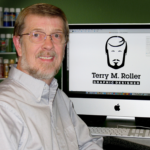 Terry Roller, Prof. Emeritus of Graphic Design, came to Waco after teaching at Eastern Illinois University to take a similar position at Baylor University in 1983. He retired from Baylor after 33 years this August. He has also been a partner and performer in the Stars Over Texas Jamboree, a first-Thursday-of-the-month, Branson-type musical stage show at the Lee Lockwood Library and Museum since its inception in 2010. His wife Janet teaches second grade at Waco Charter school where she also teaches a weekly art class for several grades. They have one daughter, Lauren, who works for Magnolia in public relations.
Terry Roller, Prof. Emeritus of Graphic Design, came to Waco after teaching at Eastern Illinois University to take a similar position at Baylor University in 1983. He retired from Baylor after 33 years this August. He has also been a partner and performer in the Stars Over Texas Jamboree, a first-Thursday-of-the-month, Branson-type musical stage show at the Lee Lockwood Library and Museum since its inception in 2010. His wife Janet teaches second grade at Waco Charter school where she also teaches a weekly art class for several grades. They have one daughter, Lauren, who works for Magnolia in public relations.
The Act Locally Waco blog publishes posts with a connection to these aspirations for Waco. If you are interested in writing for the Act Locally Waco Blog, please email [email protected] for more information.
By Joel H. Scott, Ph.D.
With a rich history of critically considering how faith informs hunger alleviation while nurturing people, the land, and community, World Hunger Relief, Inc, (WHRI) is a robust, life-giving organization. As the new Director of Development & Outreach, it’s my privilege to share with Act Locally Waco followers about one of the more unique not-for-profits in the United States.
So what’s WHRI? (affectionately know as “the Farm”)
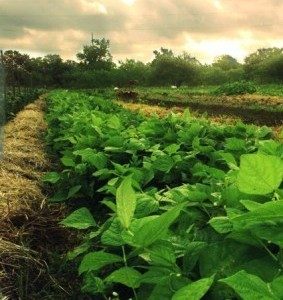 WHRI is a faith-based organization committed to the alleviation of hunger both locally and around the world.
WHRI is a faith-based organization committed to the alleviation of hunger both locally and around the world.
For 40 years WHRI has been training individuals in holistic ministry that equips for work with communities in developing sustainable agriculture, motivating individuals and communities to live sustainably and advocate on behalf of the poor, and partnering with like-minded organizations to address hunger related issues facing our local and global communities.
Where is it?
Our Physical Address is 356 Spring Lake Rd Waco, TX 76705. We are located on 40 acres just north of Waco off Hwy 77 (From I-35 Exit 342B).
So what does this training, motivating, and partnering really mean for Waco today? (Read on! The following is a snapshot of our mission in action)
 Training: WHRI has individuals from all over the world who serve as interns or live-in volunteers for 13 months and train in sustainable agriculture, spiritual development, and community engagement. WHRI has trained more than 350 interns working in 20 countries spanning 4 continents. Interns work for various domestic international organizations promoting sustainable food production and economic development. Many graduate and work for agencies in our greater Waco community such as intern Bethel Erickson-Bruce who pioneered the widely popular Waco Downtown Farmers Market in 2011.
Training: WHRI has individuals from all over the world who serve as interns or live-in volunteers for 13 months and train in sustainable agriculture, spiritual development, and community engagement. WHRI has trained more than 350 interns working in 20 countries spanning 4 continents. Interns work for various domestic international organizations promoting sustainable food production and economic development. Many graduate and work for agencies in our greater Waco community such as intern Bethel Erickson-Bruce who pioneered the widely popular Waco Downtown Farmers Market in 2011.
Currents interns represent several U.S. states and South Africa. This fall interns will be coming to train at the Farm from our international partnerships in Liberia and El Salvador.
Motivating/Educating: Each year, dozens of local organizations and faith communities (all ages) come to the Farm to wrestle with issues of food insecurity, corruption, and unequal distribution through our “Living on the Other Side” (LOTOS) experiential education exercises. Groups are empowered to consider responsible ways to alleviate modern day issues such as food deserts in their own communities.
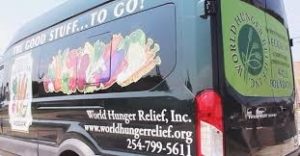 The Veggie Van: WHRI’s mobile food source, launched in 2014 to provide high quality, affordable vegetables in identified food deserts in Waco. In that time, WHRI has built relationships in the local food system (i.e. the farmer’s market vendors, other non-profits, local businesses, government officials, etc.) to reach some of the most vulnerable populations in Waco—senior citizens, the working poor, children from generational poverty and those living in underserved neighborhoods. The Veggie Van also serves as mobile educational tool for promoting awareness of local food deserts.
The Veggie Van: WHRI’s mobile food source, launched in 2014 to provide high quality, affordable vegetables in identified food deserts in Waco. In that time, WHRI has built relationships in the local food system (i.e. the farmer’s market vendors, other non-profits, local businesses, government officials, etc.) to reach some of the most vulnerable populations in Waco—senior citizens, the working poor, children from generational poverty and those living in underserved neighborhoods. The Veggie Van also serves as mobile educational tool for promoting awareness of local food deserts.
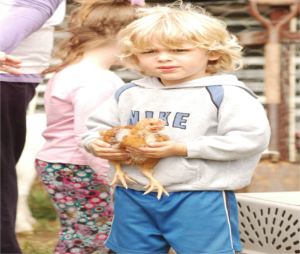 Farm Camp: During the summer, WHRI introduces Waco area children to the wonders of simple living, sustainable agriculture. Through this camp, children get to try new foods – picked fresh and warmed by the summer sun – and create a new relationship with food and the land. For more information about next year’s camp, please check out our website after February 1, 2017.
Farm Camp: During the summer, WHRI introduces Waco area children to the wonders of simple living, sustainable agriculture. Through this camp, children get to try new foods – picked fresh and warmed by the summer sun – and create a new relationship with food and the land. For more information about next year’s camp, please check out our website after February 1, 2017.
Guided Educational Tours: Over 1,300 folks visited the Farm last year on tours. WHRI has tours tailored to meet a variety of interests. We customize farm visits to fit curriculum, TEKS requirements, or learning objectives of any age or grade. We encourage visitors to consult the staff at WHRI before your visit and plan your farm experience; this can include service projects, meaningful work experiences, and pre/post-visit interactions.
Partnering: WHRI’s School Gardening Program partners with Waco ISD and local organizations in developing healthy, sustainable communities through the education and exploration in our school gardens. Currently school gardens are located at J.H. Hines Elementary, Indian Springs Middle School and G.W. Carver Middle School. We also support the Heart of Texas Urban Garden Coalition (HOT UGC) in many community wide initiatives.
Executive Director Matt Hess serves as co-chair of Live Well Waco the Healthy Eating Healthy living arm of Prosper Waco. This group has a focus on reducing obesity in McLennan County. The group is developing a Healthy Eating Active Living Plan; managing a grant from the USDA aimed at increasing awareness of healthy eating opportunities in Waco such as the Veggie Van, the Waco Downtown Farmers Market, and community gardens; and has recently been accepted as a finalist in the Healthiest Cities and Counties Challenge.
WHRI is widely known and respected for its stewardship of partnerships and relationships. We take seriously the call to join like-minded forces through consultation and collaborative endeavors, rather than competing or duplicating work.
If I want to begin a relationship with World Hunger Relief and become a “Friend of the Farm” what’s a good first step?
- E
 mail [email protected] or call World Hunger Relief’s main office (254)-799-5611and request a guided tour of the Farm.
mail [email protected] or call World Hunger Relief’s main office (254)-799-5611and request a guided tour of the Farm. - Stop by our Veggie Van during the week and at the Downtown Farmer’s Market on Saturdays.
- Visit our website at http://worldhungerrelief.org/ and request our Newsletters and Farm Notes.
- Like and Follow us on Facebook @whriwaco and share with your network.
- Purchase a fall dinner ticket and join us for “A Night on the Farm” Dinner & Celebration on Oct. 21st or 22nd. Tickets will be available here October 1st.
- Organize a group to experience our LOTOS or service learning programs offered year-round.Email our Local Education team to schedule service learning opportunities: [email protected].
- Come out and experience our infamous Spring Farm Day in April 7th, 2017.
- Email Joel Scott @ [email protected] He’d love to meet with you for coffee and discuss all things Farm.
- If you are already a supporter of the Farm, we are currently in a Match Month. The JES Foundation is doubling every dollar given up to $40,000 through Oct 1st. You can give directly online through our website http://worldhungerrelief.org/donate/
We’re grateful for WHRI’s legacy of stewardship, and our robust base of volunteers and supporters who share their talents, time and treasures. As the Farm strategically considers the next 40 years of mission-centric work, we look forward to forging new relationships, partnerships, and approaches to more faithfully address how we nurture people, the land, and community.
 Joel Scott is the new Director of Development & Outreach at World Hunger Relief, Inc. He recently served on faculty at Boston University and worked in higher education administration, capacity consulting, and leadership for the past 15 years. His primary scholarship involves community-university engagement and service-learning. Joel is looking forward to fall backyard barbeques, driveway basketball, and living a more integrative life.
Joel Scott is the new Director of Development & Outreach at World Hunger Relief, Inc. He recently served on faculty at Boston University and worked in higher education administration, capacity consulting, and leadership for the past 15 years. His primary scholarship involves community-university engagement and service-learning. Joel is looking forward to fall backyard barbeques, driveway basketball, and living a more integrative life.
The Act Locally Waco blog publishes posts with a connection to these aspirations for Waco. If you are interested in writing for the Act Locally Waco Blog, please email [email protected] for more information.
By Craig Nash
“The Texas Hunger Initiative is a capacity-building collaborative organization… “
So begins the official description of what my organization does. Like most first words of a mission statement, it is full of all the pretty phrases, designed to make you feel good about what is coming next. And when it works, it does create positive energy, but “collaboration” can be one of the most difficult tricks to pull off in the non-profit world. And as we all know, you can delete “non-profit” from the previous sentence and it functions just as well.
Working together isn’t something we are hardwired to do. A visit to the nearest playground right before naptime will provide sufficient evidence of this fact. But by the end of adolescence and the beginning of adulthood, we begin to understand, whether by intuition or inculcation, that it is something we should do– If for no other reason than to get a “Works well with others” stamp beside our name.
Having spent some of my time in ministry, and much (read: all) of my life in churches, the inability for faith communities to collaborate with each other is an oft-stated frustration of many, both inside and outside of congregations. “Why can’t we all just work together” is the refrain that has sparked numerous joint fellowship-dinners and worship services, each of which fizzle out once the churches actually start talking about working on a project together. Now that I’ve been around non-profits and other businesses for a short amount of time, I am seeing that it is not a phenomenon exclusive to churches.
Why is collaboration so difficult?
I think a story I heard recently may hold the clue. (I’m being especially vague in the telling to protect the identities of all parties involved.)
An employee of a business and her boss were in a meeting. The agenda was for both of them to dream and talk about what her future in the organization might look like. The boss asked her, “If you could do anything within our business, what would it be?” She thought about it for a while and then laid out her “Dream Scenario” for her next few years within the organization. The boss thought about it for a few moments, then responded with, “I’m going to have to say ‘no.’ The things you have described are not in my professional best interest.” It should go without saying that the relationship between the employee and this organization was not long for this world.
The moral of this story isn’t that two parties can’t cooperate unless they are willing to lay aside some of their individual personal interests for the good of the partnership. (Though that is a good moral, it’s not the moral of MY TELLING of this story.) This scenario could have gone better, but I don’t think what happened here is the worst example of collaboration, because it has the one element that often causes collaborative partnerships to fizzle out. You guessed it—Honesty. The boss had no problem laying all his personal goals and ambitions on the table, as well as his unwillingness to budge with regards to what his employee wanted to happen.
I suppose this isn’t necessarily a story about the value of collaboration, but rather about the value of not wasting each other’s time if collaboration isn’t possible. It takes a little bit of a dance to pull solid collaboration off, with one party figuring out when to lead and when to follow, and there is absolutely nothing wrong with saying “You know, I don’t want to dance.” In fact, if you don’t want to dance, saying so is preferable to all the other linguistic gymnastics many often go through in an attempt to be nice.
Luckily, when it comes to partnering together to alleviate food insecurity in Waco, there are a number of organizations that ARE willing to dance the dance.
I’ve been charged with a clear mission: To drastically increase the amount of students in the Heart of Texas Region who are participating in child nutrition programs offered through the Texas Department of Agriculture, such as School Breakfast, After School and Summer meals. The Texas Hunger Initiative believes this is one of the most efficient and effective tools in solving the problem of childhood hunger. It’s not the only efficient and effective tool, though. Other organizations like Pack-of-Hope, Caritas and local churches have other “clear missions” centered on other tools. We have each found ways to “dance,” knowing that a rising tide lifts all ships.
The word “collaboration” is a lot more fun to say than it is to do. There is sweat involved. And differing opinions about “best practices,” not to mention egos and reputations at stake. I am thankful to live in a community working hard trying to figure it out.
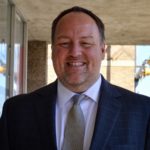 Craig Nash has lived in Waco since 2000. Since then he has worked at Baylor, been a seminary student, managed a hotel restaurant, been the “Barnes and Noble guy,” pastored a church and once again works for Baylor through the Texas Hunger Initiative. He lives with his dog Jane, religiously re-watches the same 4 series on Netflix over and over again, and considers himself an amateur country music historian.
Craig Nash has lived in Waco since 2000. Since then he has worked at Baylor, been a seminary student, managed a hotel restaurant, been the “Barnes and Noble guy,” pastored a church and once again works for Baylor through the Texas Hunger Initiative. He lives with his dog Jane, religiously re-watches the same 4 series on Netflix over and over again, and considers himself an amateur country music historian.
The Act Locally Waco blog publishes posts with a connection to these aspirations for Waco. If you are interested in writing for the Act Locally Waco Blog, please email [email protected] for more information.
